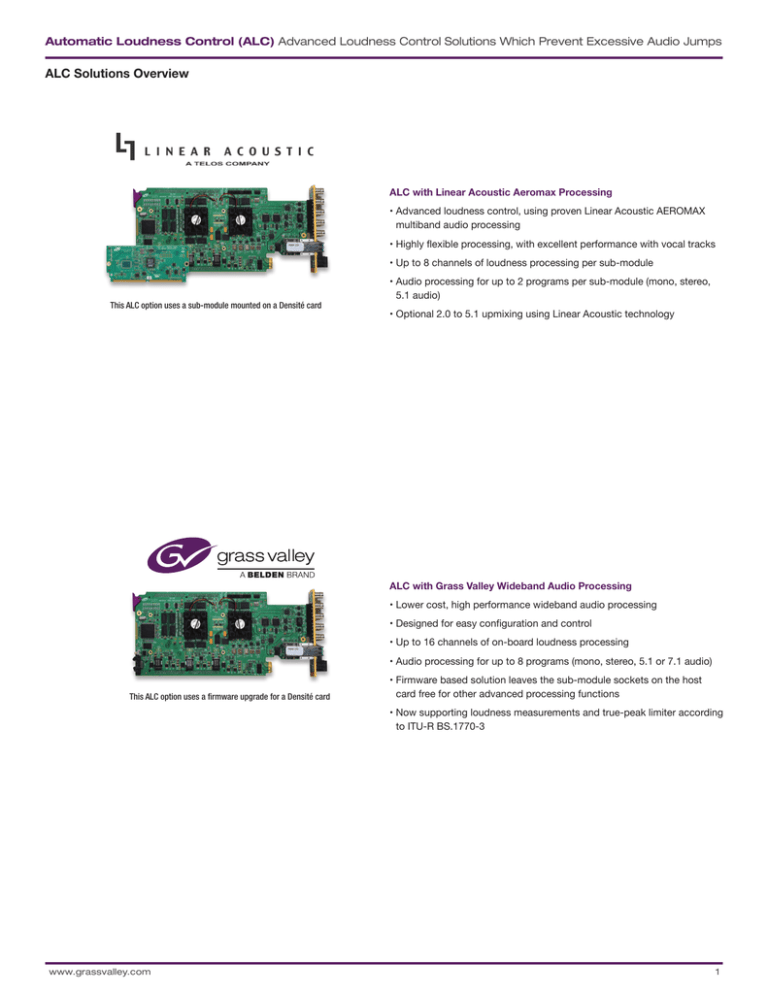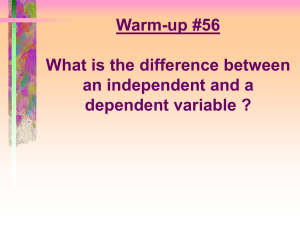
Automatic Loudness Control (ALC) Advanced Loudness Control Solutions Which Prevent Excessive Audio Jumps
ALC Solutions Overview
ALC with Linear Acoustic Aeromax Processing
• Advanced loudness control, using proven Linear Acoustic AEROMAX
multiband audio processing
• Highly flexible processing, with excellent performance with vocal tracks
• Up to 8 channels of loudness processing per sub-module
ALC option uses daughter-board with Densité module
This ALC option uses a sub-module mounted on a Densité card
• Audio processing for up to 2 programs per sub-module (mono, stereo,
5.1 audio)
• Optional 2.0 to 5.1 upmixing using Linear Acoustic technology
ALC with Grass Valley Wideband Audio Processing
• Lower cost, high performance wideband audio processing
• Designed for easy configuration and control
• Up to 16 channels of on-board loudness processing
• Audio processing for up to 8 programs (mono, stereo, 5.1 or 7.1 audio)
This ALC option uses a firmware upgrade for a Densité card
• Firmware based solution leaves the sub-module sockets on the host
card free for other advanced processing functions
• Now supporting loudness measurements and true-peak limiter according
to ITU-R BS.1770-3
www.grassvalley.com
1
Automatic Loudness Control (ALC) Advanced Loudness Control Solutions Which Prevent Excessive Audio Jumps
Automatic Loudness Control Using Linear Acoustic AEROMAX
Advanced loudness control is offered by ALC with Linear Acoustic AEROMAX audio processing. It uses a third generation audio processor to provide a
simple and cost-effective solution for guarding against loudness shifts.
Multiband Architecture
The AEROMAX algorithms use a multiband approach to loudness control. These algorithms can apply multiband, multistage loudness control to the
audio, resulting in audio free from
abrupt loudness or image shifts, while preserving more of the original content than previously possible.
This version of ALC can be packaged with, or without, the Linear Acoustic upMAX upmixer on the same submodule for optimal integration.
B1
AGC
B1 limit
(look ahead)
HF
level
B2
AGC
B2 limit
(look ahead)
HMF
level
Crossover
B3
AGC
B3 limit
(look ahead)
LMF
level
ITU-R BS.1770
compliant AGC
Crossover
B4
AGC
B4 limit
(look ahead)
MidB
level
Parametric EQ
(3 bands)
Crossover
B5
AGC
B5 limit
(look ahead)
LowB
level
Crossover
Digital
audio
input
Output limiter
(look ahead) +
loudness set
Digital
audio
output
Typical program configurations using AEROMAX
2-channel ALC with optional upmix
2.0 ALC
6-channel ALC with optional upmix
UPMIX
(-DUP)
5.1 or 2.0 ALC
8-channel ALC with optional upmix
UPMIX
(-DUP)
5.1 or 2.0 ALC
UPMIX
(-DUP)
2.0 ALC
Other channel configurations are also supported.
Upmixing is only available with the –DUP ordering codes.
Please visit www.grassvalley.com for more information.
SPECIFICATIONS
ORDERING
Architecture: 8 channel multiband (5) processing
MOD-LA-ALC-2
2-channel ALC licensed by Linear Acoustic
Number of programs: 1 or 2
MOD-LA-ALC-6
6-channel ALC licensed by Linear Acoustic
Program configuration: 2 and/or 6 audio channels
MOD-LA-ALC-8
8-channel ALC licensed by Linear Acoustic
Loudness measurement: ITU-R BS.1770
MOD-LA-ALC-2-DUP
2-channel ALC and up mix licensed by Linear Acoustic
Sampling: Up to 24 bits at 48 kHz
MOD-LA-ALC-6-DUP
6-channel ALC and up mix licensed by Linear Acoustic
Processing profiles: 6
MOD-LA-ALC-8-DUP
8-channel ALC and up mix licensed by Linear Acoustic
Limiter set range: -6 to 0 dBFS or ±6 dB
AGC pulling range: ±36 dB
www.grassvalley.com
2
Automatic Loudness Control (ALC) Advanced Loudness Control Solutions Which Prevent Excessive Audio Jumps
ALC with Grass Valley Wideband Audio Processing
Lower cost, high performance loudness control is provided by ALC using Grass Valley’s proprietary wideband audio processing algorithms. This variant
of ALC offers versatile, easily configured loudness processing, which does not adversely affect the program content.
Wideband Architecture
This ALC option uses a firmware upgrade to the hosting card. Up to eight different programs and up to 16 channels can be processed simultaneously,
with independent controls and loudness meters on each program. This ALC variant leaves the sub-module sockets on the host card free for other
advanced processing functions.
Digital audio
input
True-peak
limiter
Digital audio
output
Slow acting control
Constant
loudness
controller
Moderate acting control
Fast acting control
ITU-R BS.1770
loudness
measurment
Typical configurations
2-channel ALC
8-channel ALC
8-channel ALC
2.0 ALC
5.1 ALC
7.1 ALC
6-channel ALC
2.0 ALC
5.1 ALC
Other channel configurations are also supported.
Please visit www.grassvalley.com for more information.
SPECIFICATIONS
Architecture: 16 channel wideband processing
Number of programs: Up to 8
Program configuration: 1, 2, 3, 4, 6 or 8 audio channels
Loudness measurement: ITU-R BS.1770-3
Sampling: Up to 24 bits at 48 kHz
Processing profiles: 3/5
Target loudness range: -31 to -10 LKFS
Limiter set range: -20 to dBFS true-peak
AGC pulling range: -31 to +18 dB
Pre-gain stage range: -20 to 20 dB
www.grassvalley.com
3
Automatic Loudness Control (ALC) Advanced Loudness Control Solutions Which Prevent Excessive Audio Jumps
Segment-to-Segment: Active Loudness Control
Grass Valley’s ALC solutions can be operated in a ‘set-and forget’ mode,
with the setting of an output Target Loudness per program. This mode
can achieve excellent results, and the performance can be optimized by
selecting a loudness processing profile that best matches the content of
the facility.
An alternative approach to loudness processing involves using playout
automation to actively control the loudness processing profile, according
to the type of content. This can yield improved results when the facility
uses a significant amount of programming with a controlled loudness level
or a reliable Dialnorm value.
In the example below, a facility controls three different profiles by playout
automation to create an optimal loudness processing result, with minimal
impact to the original program dynamics. The three different profiles
provide aggressive loudness control for commercials, light processing
for a movie with an uncontrolled loudness level, and a complete bypass
of the ALC processing for a program with the correct loudness level or a
reliable Dialnorn value. Traditionally, the most problematic content from a
loudness control perspective has been commercial and promo insertions.
Program
Segments
Program with correct loudness
level or reliable Dialnorm value
Loud promo
Movie with uncontrolled
loudness level
Automation
Decisions
ALC is bypassed
ALC is engaged
with an agressive profile
ALC is engaged
with a light profile
Audio remains intract with its original
dynamics while the program meets
station’s target loudness
Audio level matches target loudness
but compression will likely affect
original dynamics
Audio level matches target loudness
with a slight impact on the original
film audio dynamics
Effects on
Original Audio
Active Control of ALC by Playout Automation
Headend Uses Decoding, ALC Audio Processing, and Re-encoding
Can fix both channel-to-channel and segment-to-segment loudness problems.
Note: This configuration is possible if the audio compression algorithm and
the bit rate in use allow for an extra generation of encoding without creating
audible artifacts when decoded at final destination.
Consistent loudness
Service
provider
feed
Decode
audio
Automatic loudness control (ALC)
Measure
loudness
Encode
audio
Video
encoder
Compare
Target loudness
Mux
Densité signal processor module
Note: This configuration is possible if the audio compression algorithm and the bit rate in use allow for an extra generation of encoding without creating audible artifacts
when decoded at final destination.
www.grassvalley.com
4
Automatic Loudness Control (ALC) Advanced Loudness Control Solutions Which Prevent Excessive Audio Jumps
Playout using ‘set and forget’ mode with ALC
• Output target loudness is maintained by ALC
• Loudness control can be optimized by choosing an ALC profile that best matches
the facility’s content
Master
control
ALC
UPMIX
Dolby Digital
encoder
Consistent loudness
Transmission
encoder
Metadata generator
Constant 5.1
surround Field (-DUP)
Densité signal processor module
Playout using active control of ALC by automation system
• Automation triggers different ALC profiles according to the program content, driven by content tagging performed by the traffic team
• By adapting the ALC profiles to the content, there is minimal impact to original program dynamics
Consistent loudness
Master
control
ALC
UPMIX
Dolby Digital
encoder
Transmission
encoder
Metadata generator
Constant 5.1
surround Field (-DUP)
Densité signal processor module
Automation
Dolby Decode/ALC at ingest
IRD
Dolby Decoder
ALC
Ingest Server
IRD
Densité signal processor module
www.grassvalley.com
All ingested content
matches the station’s
Target Loudness level
5
Automatic Loudness Control (ALC) Advanced Loudness Control Solutions Which Prevent Excessive Audio Jumps
Channel-to-Channel Loudness Control: ALC at Head-ends
Channel-to-channel loudness inconsistencies are another key issue,
especially for cable and IPTV service providers. It’s common for viewers
to experience different loudness levels as they switch between channels,
and this is because the channels will have different average loudness and
inconsistent dialnorm values.
Fortunately, Grass Valley’s automatic loudness control solutions can
be used to address the problem by decoding and processing the audio
with ALC, and then re-encoding. The Densité signal processor card can
re-stamp a consistent Dialnorm value to match the target loudness value
used by the ALC processor.
Often, the cause of this channel-to-channel loudness variation is the
broadcaster’s use of a default -27 dB DialNorm value for the Dolby Digital
encoder when there is significant variation in the average loudness of the
program segments.
1
• Avg. loudness:
• Dialnorm:
-24 dB and consistent
-24 dB fixed
2
• Avg. loudness:
tent
• Dialnorm:
-27 dB and consis-
3
• Avg. loudness:
tent
• Dialnorm:
-28 dB and consis-
4
• Avg. loudness:
• Dialnorm:
varies by segment
varies by segment
5
• Avg. loudness:
varies by segment
• Dialnorm:
-24 dB fixed
-27 dB fixed
-24 dB fixed
IPTV or
cable
To home STB
system
Typical loudness scenario in IPTV / cable system with a mix of loudness levels across channels
GVB-1-0351A-EN-PH
WWW.GRASSVALLEY.COM
Join the Conversation at GrassValleyLive on Facebook, Twitter,
YouTube and Grass Valley - A Belden Brand on LinkedIn.
Belden, Belden Sending All The Right Signals and the Belden logo are trademarks or registered trademarks of Belden Inc.
or its affiliated companies in the United States and other jurisdictions. Grass Valley, Densité and iControl are trademarks or
registered trademarks of Grass Valley. Belden Inc., Grass Valley and other parties may also have trademark rights in other
terms used herein.
Copyright © 2014 Grass Valley. All rights reserved. Specifications subject to change without notice.
6



